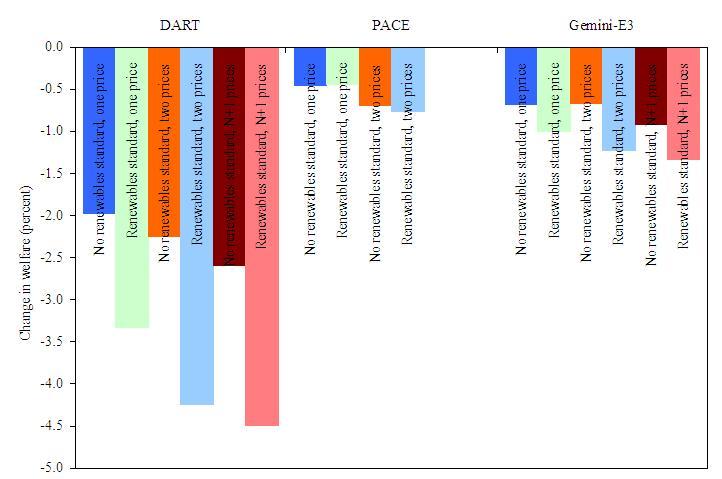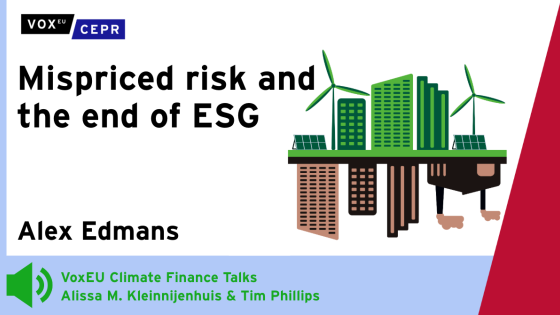The EU is committed to limiting the rise in global average temperature to 2°C above pre-industrial levels (Council of the EU 2009). It has set ambitious targets for greenhouse gas emissions reduction. At the same time, the EU has adopted equally ambitious targets for the portfolio of energy supply. The EU aims to meet these targets through a range of policy instruments at the union, member and sub-national levels. Tinbergen (1952) cautioned policymakers that welfare losses are likely if the number of instruments and targets do not match. We use the results of three computable general equilibrium models (Bernard and Vielle forthcoming, Böhringer et al. forthcoming, Kretschmer et al. forthcoming) to provide estimates of the size of such welfare losses and insights into the mechanisms behind the inefficiencies.
The EU emission targets
The EU has committed to reducing greenhouse gas emissions to 20% below their 1990 levels by 2020 (CEC 2008). About half of these emissions – essentially all energy-intensive industries – are to be regulated under the European Trading Scheme (ETS). The target is 21% below 2005 levels. The other half of greenhouse gas emissions are currently unregulated at the EU level but subject to emissions control measures by individual member states. The average target is -10% in 2020, but member state targets range from a 20% decrease to a 20% increase relative to 2005. Achieving these targets is left to the member states, but they are allowed to trade a fraction (5%) of their allocations among themselves. Another small fraction (3%) of the emission reduction obligations may be achieved outside the EU. The second headline target is a 20% penetration of renewable energy by 2020. There are targets for every member state, but these obligations are also tradable.
Furthermore, there is a 10% target for the 2020 market share of renewable transport fuels, and an EU-wide aspiration to improve energy efficiency by at least 20% between 2005 and 2020. There is a fuel efficiency target for passenger cars, although one could also argue that this is a bilinear tax. Incandescent light bulbs will be banned. The European Parliament has considered banning patio heaters and daylight saving time. The EU member states have a variety of additional measures, including carbon taxes, appliance subsidies, tax breaks for bicycle owners, standards for tyre pressure, and tests for fuel efficient driving. At the same time, there is continued support for fossil fuels, car transport, agriculture, and other activities that emit disproportionate amounts of greenhouse gases (Böhringer et al. forthcoming).
The welfare costs of EU carbon policy
This tangle of targets and instruments creates a climate policy that is excessively costly. The three multi-regional, multi-sector general equilibrium models used in our study cannot possibly reflect the true complexity of climate and energy policy in the EU. Instead, we designed a set of stylised scenarios that (1) highlight the main inefficiencies and (2) attribute these to the various elements of the regulations:
- No additional policy
- 20% emissions reduction
- Uniform carbon price
- Uniform carbon price in ETS and non-ETS
- Uniform carbon price in ETS; non-ETS carbon prices vary by member state
- 20% emissions reduction and 20% renewables
- Uniform carbon price
- Uniform carbon price in ETS and non-ETS
- Uniform carbon price in ETS; non-ETS carbon prices vary by member state
If implemented at the lowest possible cost, the 20% emissions reduction for 2020 would lead to loss of consumption of 0.5%–2.0% or €135–€540 billion. The policy period is 2013–2020, so the highest estimate suggests a loss of one year of growth in eight, while the lowest estimate suggests that climate policy is not that expensive.
Not surprisingly, second-best policies increase costs. A policy with two carbon prices (one for the ETS, one for the non-ETS) rather than one could increase costs by 0%≠53%. The lower bound holds in the unlikely case that policy makers perfectly know the cost of emission reduction in each sector and member state and accurately predict future emissions. A policy with a single carbon price for the ETS and different carbon prices of the non-ETS emissions of each of the member state could increase costs by another 15%–39%.
The renewables standard reduces emissions so that other climate policy can be less stringent. The price of emission permits therefore falls, by 3%–37% depending on the model and the scenario. Carbon prices create an incentive to invest in R&D, while a standard creates such incentives only up to the point that the target is met. The renewables standard raises the costs of emissions reduction by up to 90%.
Overall, the inefficiencies in policy lead to a cost that is 100%-125% too high. Some models claim that is largely because of the renewables target and other models blame the excess costs on the ETS/non-ETS. The models agree, however, that there is a substantial and unnecessary welfare loss of the order of hundreds of billions of euros to meet the climate policy target.
We find that the marginal, total, and excess costs reported here are (much) higher than in the official impact assessment of the European Commission (Capros et al 2008). That impact assessment is based on a single model and a single scenario. Our three models show that neither market splits nor additional targets necessarily lead to excess costs. We can thus construct a model and scenario that reproduces the results of the European Commission. We could also construct a model and scenario in which both market splits and additional targets lead to an excess cost that is much higher than what is shown here.
The above results should be treated with caution. The numbers are neither accurate nor precise. They are ballpark estimates. What really matters are the insights. Climate policy need not cost a lot, but imperfect implementation implies excess costs. The excess costs are substantial relative to the costs of the first-best policy. Unfortunately, and indiscernible from the official impact assessment, actual climate policy is far from first-best.
Figure 1. The change in welfare in the EU in 2020 according to three different models for six different policy scenarios
Source: (Böhringer et al., forthcoming)
References
Bernard, A. and M.Vielle (forthcoming), “Assessment of European Union transition scenarios with a special focus on the issue of carbon leakage”, Energy Economics.
Böhringer, C., A.Löschel, U.Moslener, and T.F.Rutherford (forthcoming), “EU Climate policy up to 2020: An economic impact assessment”, Energy Economics.
Böhringer, C., T.F.Rutherford, and R.S.J.Tol (forthcoming), “The EU 20/20/2020 Targets: An overview of the EMF22 assessment", Energy Economics.
Capros, P., L.Mantzos, V.Papandreou, and N.Tasios (2008), Model-based Analysis of the 2008 EU Policy Package on Climate Change and Renewables, E3M Lab, National Technical University, Athens.
CEC (2008), Proposal for a Decision on the European Parliament and of the Council on the Effort of member states to Reduce their Greenhouse Gas Emissions to Meet the Community's Greenhouse Gas Emission Reduction Commitments up to 2020 COM(2008) 17 final, Commission of the European Communities, Brussels.
Council of the European Union (2009), Brussels European Council 29/30 October 2009, Presidency Conclusions 15265/09, Council of the European Union, Brussels.
Kretschmer, B., D.Narita, and S.Peterson (forthcoming), "The economic effects of the EU biofuel target", Energy Economics.
Tinbergen, J. (1952), On the Theory of Economic Policy North Holland, Amsterdam.





